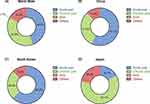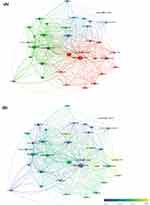Back to Journals » Journal of Pain Research » Volume 16
Bibliometric Analysis of Research Articles on Virtual Reality in the Field of Pain Medicine Published from 1993 to 2022
Authors Kim J , Jun K, Park S, Lee SW
Received 12 September 2023
Accepted for publication 4 November 2023
Published 13 November 2023 Volume 2023:16 Pages 3881—3893
DOI https://doi.org/10.2147/JPR.S432113
Checked for plagiarism Yes
Review by Single anonymous peer review
Peer reviewer comments 2
Editor who approved publication: Dr Jonathan Greenberg
Jeongsoo Kim,1,2 Kwanghoon Jun,1 Seyong Park,1 Sang Won Lee3,4
1Department of Anesthesiology and Pain Medicine, Seoul National University Hospital, Seoul, Republic of Korea; 2Department of Anesthesiology and Pain Medicine, Seoul National University College of Medicine, Seoul, Republic of Korea; 3Department of Pharmacology, Hanyang University College of Medicine, Seoul, Republic of Korea; 4Department of Clinical Pharmacology and Therapeutics, Hanyang University Seoul Hospital, Seoul, Republic of Korea
Correspondence: Sang Won Lee, Department of Pharmacology, Hanyang University College of Medicine, Seoul, Republic of Korea, Tel +82 2 2290 9664, Email [email protected]
Purpose: This study aims to analyze global and regional (China, Japan, and South Korea) research on virtual reality (VR) in the field of pain medicine over the past 30 years. Specifically, we quantify VR-related publications, examine the distribution of research topics on chronic and acute pain, and identify trends and future directions.
Methods: The Web of Science Core Collection (WoSCC) database was used for bibliometric analysis. This study included articles written in English between 1993 and 2022. The search strategy used predefined terms related to VR and pain. Based on the articles’ titles and abstracts, two pain physicians independently reviewed and classified them as acute or chronic pain. Quantitative data on countries, institutions, journals, and research categories were analyzed. VOSviewer software was used for keyword mapping and clustering.
Results: We analyzed 808 VR-related articles on pain medicine. Over the past three decades, the number of publications in this field has increased steadily. The United States of America (n = 259) had the highest number of publications. Moreover, China (n = 42), Japan (n = 18), and South Korea (n = 24) also contributed continuously. Acute and chronic pain research accounted for 44.2% and 37.9% of the articles, respectively. The most common acute pain topic was procedure-related (n = 129, 16.0%), whereas the most common chronic pain topic was neuropathic (n = 104, 12.9%). Keywords clustered around neuroscience, pediatric pain management, and chronic pain management.
Conclusion: Our study revealed academic achievements and growing interest in VR-related research in pain medicine. Researchers worldwide have shown balanced interest in applying VR technology to acute and chronic pain, with specific contributions from China, Japan, and South Korea. Harnessing VR technology is promising for improving pain management and enhancing patients’ quality of life in the field of pain medicine.
Keywords: bibliometrics, virtual reality, pain management, China, Korea, Japan
Introduction
Virtual reality (VR) is an advanced technology that allows users to interact with a simulated environment as if it were real. Using computer-generated graphics, audio, and occasionally even touch and smell, VR creates an immersive and interactive experience that may transport users to entirely new worlds.1 The concept of VR has existed for several decades; however, recent technological advancements have made it more accessible and realistic than ever before.2 Recently, VR has been used in various industries, including entertainment, education, and healthcare.3–6 The potential of VR to provide non-pharmacological pain management that can reduce opioid consumption is among its most exciting aspects, especially in medicine.7 By immersing patients in a calming and distraction-filled environment, VR reduces pain levels during painful procedures.8–10 As VR technology advances and its applications expand, it is anticipated that it will be increasingly utilized not only in procedure-related pain management but also in the overall field of pain medicine.11
Bibliometric analysis is a quantitative and qualitative research method that involves analyzing publications and their citations to understand the patterns of knowledge production and dissemination. It is a valuable tool for evaluating the impact of research and identifying emerging trends in a particular field.12 Bibliometric analysis can provide information on the research composition of particular fields by examining the countries, institutions, and authors involved in research. Using information gathered through bibliometric analysis, researchers can determine the current research status and future directions in a specific field. Recently, bibliometric analysis has been used extensively in the field of medicine.13–15 Furthermore, it is also widely used in the field of pain medicine.16–18
Although, recent review articles11,19 including the one by Trost et al examined the utilization of VR in the field of pain medicine, and provided a broad overview of the field, they did not provide an in-depth quantitative analysis of the literatures, such as temporal and geographical distributions, or keyword associations. In that sense, we believe it would be inaccurate to categorize these articles as bibliometric analyses. Thus, there appears to be a lack of bibliometric research on academic achievements related to VR in the field of pain medicine.
In light of the above-mentioned research gap, we performed a bibliometric analysis to have a more comprehensive understanding with regard to the VR-related studies in the field of pain medicine over the past 30 years. This study will begin by summarizing the publication and citation trends in terms of time and region. We will then describe the distribution of the published articles in terms of countries, institutions, research categories, and journals. In addition, we will present the relative distribution of acute and chronic pain studies within the publications. Finally, we will identify and categorize the keywords to gauge the interests of researchers and discover emerging trends. By doing so, this study aimed to convey the information gathered to date and suggest future research directions.
Materials and Methods
Ethics Statement
This study was approved by the Institutional Review Board of Hanyang University Seoul Hospital (IRB No. HYUH-2023-08-049) and conducted in accordance with the Declaration of Helsinki.
Source of Data and Search Strategy
We have selected the publicly accessible the Web of Science Core Collection (WoSCC) database, which includes the Science Citation Index Expanded (SCIE), Social Sciences Citation Index (SSCI), Arts and Humanities Citation Index (A&HCI), and Emerging Sources Citation Index (ESCI). This database is also widely used in bibliometric analysis.20 The retrieval strategy was as follows: TS = (“virtual reality*” OR “augmented reality*” OR “mixed reality*” OR “computer-mediated reality*”) AND TS = (pain* or nocicep* or ache* or analg* or headache* or migraine* or ‘stomachache*’ or ‘abdominal ache*’ or toothache* or ‘neck pain’ or ‘back pain’ or ‘musculoskeletal pain’ or sciatic* or fibromyalg* or neuralgi* or hyperalg* or radiculalg*or arthralg* or causalg*or earache*or ‘cancer pain’ or osteoarthritis or arthritis).18,21 We retrieved detailed information from WoSCC, including authors, abstracts, countries, institutions, journals, citation information, and research categories. Only articles indexed in the SCIE, ESCI, SSCI, and A&HCI were included among WoSCC’s original English-language articles written between 1993 and 2022. We also identified the ten articles with the highest citation count using the following search terms: TI = (‘virtual reality*’ OR ‘augmented reality*’ OR ‘mixed reality*’ OR ‘computer-mediated reality*’) AND TI = (pain* or nocicep* or ache* or analg* or headache* or migraine* or ‘stomachache*’ or ‘abdominal ache*’ or toothache* or ‘neck pain’ or ‘back pain’ or ‘musculoskeletal pain’ or sciatic* or fibromyalg* or neuralgi* or hyperalg* or radiculalg*or arthralg* or causalg*or earache*or ‘cancer pain’ or osteoarthritis or arthritis) NOT TI = (painting). We searched using TI rather than TS to obtain a list of the most highly cited articles directly related to pain and VR.
Screening and Data Collection
Two pain physicians (J Kim and K Jun) independently reviewed the titles and abstracts of the articles obtained from the search. Proceedings papers, review articles, duplicate articles, letters, and articles addressing topics of no interest were excluded. Even if they were related to VR and pain, we also excluded studies that did not directly involve human subjects, such as those describing program principles, study design, or protocols. In cases where it was difficult to decide individually, we decided whether to exclude the article based on the two pain physicians’ agreement. Additionally, each article was classified as relating to acute or chronic pain. Studies that did not involve patients, such as those that applied pain stimuli to healthy participants or those conducted for educational purposes, were classified as “others”. On the one hand, studies explicitly mentioning chronic pain in their titles or abstracts or targeting pain lasting three months or longer were classified as chronic pain research. On the other hand, studies focusing on specific intervention-related pain or acute pain were classified as acute pain research. According to related topics, acute pain was classified as burn, perioperative, wound, procedure-related, and dental-related pain. Procedure-related articles included those on medical procedures performed without general anesthesia or sedation, such as intravascular catheterization, biopsy, injection, and intervention, as well as those unrelated to wound care, burn care, or dental procedures. Chronic pain was classified as low back pain; neck pain; headache; fibromyalgia; musculoskeletal pain; neuropathic pain; cancer pain; abdominal pain; and eye, ear, and chest pains not belonging to these categories were classified as others. Musculoskeletal pain included topics, such as arthralgia and muscle pain, that were not included in low back pain or neck pain. In contrast, neuropathic pain included complex regional pain syndrome, post-herpetic neuralgia, spinal cord injury, phantom limb pain, and central post-stroke pain. Patients with multiple pain disorders were classified as having mixed-pain symptoms. When it was difficult to decide individually, this work was also decided upon through the consensus of the two pain physicians.
Bibliometric Analysis
We conducted a search in the WoSCC database based on our predefined search strategy and performed bibliometric analysis using the data obtained from it. We analyzed the following: (1) time trends of publications and citations (global and regional), including total number of publications, total number of citations, h-index and top 10 most cited articles, (2) distribution of countries, journals, institutions and research categories (global and regional), (3) distribution related to acute pain, chronic pain and specific pain (global and regional), and (4) keywords.
To map and cluster keywords, VOSviewer software (version 1.6.19; Leiden University, Leiden, Netherlands) was utilized. VOSviewer is a popular software tool for creating maps based on network data and for easily visualizing and exploring these maps.22 It estimates the affinity of keywords based on the number of co-occurrences of words that appear frequently in the article’s title or abstract. The connections among nodes indicate the co-occurrence of keywords; the thickness of a connection is proportional to the frequency of co-occurrence, and the node’s size represents the number of publications. The average publication year is an indicator that provides an overview of the temporal distribution of a set of documents, and It was calculated as the sum of all publication years divided by the number of publications. Note that the average publication year is not an actual calendar year, and the decimal merely indicates how skewed the dataset is between the two nearest whole years.
Results
Time Trends of Publications and Citations
By searching the WoSCC database, 1399 VR-related articles in the field of pain medicine were identified. Of these, 808 articles were analyzed (Figure 1). The number of publications and citations of VR-related articles in pain medicine has steadily increased over the past three decades (Figure 2A). The total number of citations, average number of citations per article, and h-index of VR-related articles in pain medicine over the past three decades were 17,102, 21.2, and 63, respectively (Table 1). The numbers of VR-related articles published in pain medicine over the past 30 years in China, Japan, and South Korea, which are three Far East Asian countries, were 42 (5.2%), 18 (2.2%), and 24 (3.0%), respectively. After the 2000s, all three countries began publishing articles for the first time. Unlike the global trend, it is difficult to determine whether the number of publications or citations in China, Japan and South Korea is steadily increasing (Figure 2B-D). The total number of citations, average number of citations per article, and h-index of VR-related articles in pain medicine published in China were 524, 12.5, and 12, respectively; in Japan, 371, 20.6, and 10, respectively; and in South Korea, 369, 15.4, and 12, respectively (Table 1). Table 2 shows the ten most-cited articles directly related to pain medicine and VR.23–32
 |
Table 1 The Total Number of Citations, Average Number of Citations per Article and h-Index of Virtual Reality Related Articles in Pain Medicine |
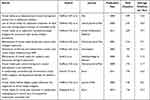 |
Table 2 Top 10 Most-Cited Virtual Reality-Related Research Articles in the Field of Pain Medicine |
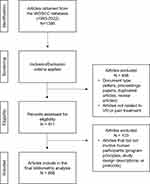 |
Figure 1 Flow diagram for article selection. WOSCC, Web of Science Core Collection. |
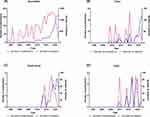 |
Figure 2 The number of publications and citations on virtual reality-related research articles in the field of pain medicine. (A) Worldwide, (B) China, (C) South Korea, and (D) Japan. |
Countries, Institutions, Journals and Research Categories
Figure 3 depicts the top 10 countries, institutions, journals, and research categories where the most VR-related articles in the field of pain medicine were published during the past three decades. The United States of America (n = 259, 32.1%) published the most articles; it was followed by Australia (n = 53, 6.6%) and England (n = 45, 5.6%). China (n = 42, 5.2%), South Korea (n = 24, 3.0%), and Japan (n = 18, 2.2%) were ranked 4th, 9th, and 11th, respectively. In terms of institutions, the University of Washington (n = 51, 6.3%) published the most articles, with an h-index of 32, and it was followed by the University of Queensland (n = 21, 2.6%), with an h-index of 14. In China, Fudan University (n = 5) and North Sichuan Medical University (n = 5) published the most articles, and both of them had an h-index of 3. In Japan and South Korea, the University of Tokyo (n = 6) and Seoul National University (n = 11) published the most articles, with h-indices of 6 and 5, respectively. The journal with the greatest number of published articles was Burns (n = 20, 2.5%), with an impact factor (IF) of 2.609; it was followed by the Journal of Clinical Medicine (n = 17, 2.1%), with an IF of 4.964. In China, the journals with the most published articles were the Journal of Clinical Nursing (n = 2, IF = 4.423), the International Journal of Clinical and Experimental Medicine (n = 2), Trials (n = 2, IF = 2.728), and Frontiers in Surgery (n = 2, IF = 2.568). Pain Medicine (n = 2, IF = 3.637) and Frontiers in Human Neuroscience (n = 2, IF = 3.437) published the most articles in Japan, whereas the Journal of Clinical Medicine (n = 3) published the most articles in South Korea. Clinical Neurology (n = 97, 12.0%) was the most prevalent research category in which VR-related articles were published in pain medicine, and it was followed by Rehabilitation (n = 91, 11.3%). Among articles published in China, the most common research category was Surgery (n = 9), whereas in Japan and South Korea, the most common research categories were Neurosciences (n = 4) and Medicine, General & Internal (n = 5), respectively.
Acute Pain and Chronic Pain
Figure 4 shows that VR-related articles in the field of pain medicine are classified as acute or chronic pain. A total of 357 (44.2%) and 306 (37.9%) articles were related to acute and chronic pain, respectively. Among the articles published in South Korea, 15 (62.5%) and 6 (25.0%) were related to acute and chronic pain, respectively; in Japan, 3 (16.7%) and 11 (61.1%) articles were related to acute and chronic pain, respectively; in China, 24 (57.1%) and 13 (31.0%) articles were related to acute and chronic pain, respectively. The VR-related articles in the field of pain medicine were subdivided into related topics, as shown in Figure 5. The most prevalent topics among articles on acute and chronic pain were procedure-related (n = 129, 20.0%) and neuropathic pain (n = 104, 12.9%), respectively. In South Korea, the most common topics among articles on acute and chronic pain were perioperative (n = 10) and musculoskeletal pain (n = 3); in Japan, the topic of articles on acute pain was only perioperative (n = 3), whereas the most prevalent topic among articles on chronic pain was neuropathic pain (n = 9). In China, the most common topics among articles on acute and chronic pain were perioperative (n = 13) and neuropathic pain (n = 7), respectively.
 |
Figure 5 The number of publications on virtual reality-related research articles in the field of pain medicine by research topics. (A) Worldwide, (B) China, (C) South Korea, and (D) Japan. |
Keywords
From the articles, 2360 keywords were extracted. The most frequently occurring keyword was “virtual reality” (n=213), followed by “pain” (n=192) and “distraction” (n=164). The keywords were classified into three clusters. Cluster 1 (blue) mainly concerned neuroscience and cognitive enhancement; Cluster 2 (green) mainly concerned pediatric pain management, anxiety reduction, and pain coping strategies; and Cluster 3 (red) mainly concerned chronic pain management, physical rehabilitation, and outcome measures. “Quality-of-life” had the latest average publication year, which was 2019.87, and it was followed by “technology” and “adults”, both of which had an average publication year of 2019.63 (Figure 6).
Discussion
Our research shows that VR-related publications in pain medicine have reflected an increasing trend over the past three decades. Thus, the application of VR technology in the field of pain medicine has steadily attracted researchers’ attention. Since the 2000s, the three Far Eastern countries, including China, Japan, and South Korea, have consistently contributed to VR-related publications in the field of pain medicine. Moreover, we analyzed the distribution of VR-related publications across the spectrum of acute and chronic pain in the field of pain medicine. This study provides the achievements and composition of VR-related research so far in the field of pain medicine. Consequently, it provides pain physicians with valuable information for planning future research.
Our results show that VR-related studies in the field of pain medicine over the past three decades have focused more on pediatric and acute pain management. The top 10 most cited VR-related articles were mainly about burn or wound pain, four of which were about pediatric patients, and one of the clusters of keywords was related to pediatric pain. Burn and wound pain are well-known causes of severe pain, especially in pediatric patients.23 In pediatric patients, the experience of pain and anxiety can lead to poor recovery and avoidance of treatment.33 Immersing children in VR distracts them from painful procedures, which reduces acute pain and anxiety.34 Meanwhile, our analysis demonstrated that the keywords of VR-related studies in the field of pain medicine were shifting to chronic pain management and physical rehabilitation. Traditionally, the application of VR technology in the treatment of acute pain has focused primarily on the use of distraction techniques. However, there has recently been an increasing interest in utilizing VR technology for persistent pain patients to analyze movement patterns and apply behavioral interventions.35 The application of VR in chronic pain improves mood,36 provides psychological support,37 and supports specific movements.38 The most recent keyword in our analysis was “quality of life”, which means that VR relieves pain through distraction and improves “quality of life” in pain patients by inducing mental support and active movement. In the context of chronic pain, extensive research has been conducted globally on neuropathic pain. This line of research focuses on disorders such as complex regional pain syndrome, post-herpetic neuralgia, and phantom limb pain, which are characterized by severe and debilitating pain.16,39,40 Consequently, it is anticipated that chronic neuropathic pain disorders will continue to be an increased focus of future pain-related research utilizing VR technology.
Owing to their geographical and ethnic similarities, China, Japan, and South Korea have long influenced each other as neighboring countries. In the field of pain medicine, it has already been established that comparisons across countries within the same Far East Asian region are important.41–44 Since the 2000s, this study shows that three Far East Asian countries have consistently contributed to VR-related publications in the field of pain medicine. Regarding the number of publications, China (n = 42) ranked 4th, South Korea (n = 24) ranked 9th, and Japan (n = 18) ranked 11th. However, compared with the leading country, the United States (n = 259), these numbers are relatively low, indicating that further progress is required in VR-related research by these Far East Asian countries to become leaders in the field. Nonetheless, the growing contributions from the three Far East Asian countries hold notable significance. Considering the ethnic differences associated with pain,45 the ongoing rise in publications from these three Far East Asian nations plays a pivotal role in enhancing ethnic diversity within this research field. This diversity is an essential component of the broader endeavor to advance VR-related pain medicine on a global scale.
A distribution analysis of pain medicine articles revealed that both China and South Korea emphasized acute pain more than chronic pain. This differs from the situation in Japan, where more articles have focused on chronic pain. Examining specific research topics, South Korean and Chinese researchers showed keen interest in applying VR technology to perioperative-related pain. In contrast, Japanese researchers were interested in applying VR to neuropathic pain. This may be because Japan is a super-aging society;46 therefore, researchers have become interested in chronic pain, especially neuropathic pain. It would be interesting to observe whether China and South Korea follow a similar path as aging societies evolve. These findings highlight the varied research interests and priorities within Far East Asian countries in the field of pain medicine. Continued research and collaboration in VR-related studies may be crucial for future advancements and contributions from these countries.
The potential of VR technology to reduce opioid consumption is a promising aspect of its application in the field of pain medicine.7 The use of opioids for acute and chronic pain management has increased steadily,47 and this trend is not limited to Western countries. There has been an explosive rise in the use of opioids in countries such as South Korea.47,48 This increase is associated with side effects such as respiratory distress and addiction, leading to significant social problems.49 Therefore, it is crucial to thoroughly explore alternative options that offer effective pain management while reducing opioid use. Because VR has the potential to alleviate severe pain by offering non-pharmacological pain management techniques,7 further VR-related studies are expected to explore its potential in reducing opioid consumption. Consequently, this would contribute to developing alternative pain management strategies, ultimately addressing the growing concerns associated with opioid use.
Our study had some limitations that need to be acknowledged. First, our search terms may not have captured the entire field of pain medicine. Despite the use of search terms established in previous studies,18,20 pain medicine is a vast field, and it is possible that some relevant studies were inadvertently excluded. Second, non-English articles were excluded from the analyses. Therefore, meaningful publications written in languages other than English may not have been analyzed. However, we believe that our analysis will not deviate significantly from overall trends because international journals are predominantly published in English.50 Third, our analysis was limited to the WoSCC database, so some publications not included in this database might have been excluded from our analysis. However, the WoSCC database, which includes important indices such as the SCIE and ESIC, is widely used in bibliometric analysis. Therefore, we believe that using only the WoSCC database does not pose significant issues in determining our research results. Finally, there may be a bias in the rankings of the top 10 most-cited articles because recently published articles, even if highly interesting, may have lower citation counts than older ones. These limitations should be considered when interpreting this study’s findings.
Conclusion
This study depicted the academic achievements of VR-related research in the field of pain medicine over the past three decades. The application of VR technology in the field of pain medicine has gained increasing interest among researchers worldwide, and this trend is expected to continue in the future. Researchers have shown a balanced interest ranging from acute pain, such as procedure-related and perioperative-related pain, to chronic pain, such as neuropathic pain. Our study highlights the contributions of three Far East Asian countries (China, Japan, and South Korea) and their specific areas of interest within the field. Researchers in the field of pain medicine can anticipate harnessing the application of VR technology to control both acute and chronic pain, ultimately improving the quality of life of patients with pain.
Abbreviations
VR, Virtual reality; WoSCC, Web of Science Core Collection; SCIE, Science Citation Index Expanded; SSCI, Social Sciences Citation Index; A&HCI, Arts and Humanities Citation Index; ESCI, Emerging Sources Citation Index; TS, Topic search; TI, Title search; IF, Impact factor.
Funding
The authors have no sources of funding to declare for this manuscript.
Disclosure
The authors declare no conflicts of interest in this work.
References
1. Azuma RT. A survey of augmented reality. Presence Teleoperators Virtual Environ. 1997;6(4):355–385. doi:10.1162/pres.1997.6.4.355
2. Muñoz-Saavedra L, Miró-Amarante L, Domínguez-Morales M. Augmented and virtual reality evolution and future tendency. Appl Sci. 2020;10(1):322. doi:10.3390/app10010322
3. Bates J. Virtual reality, art, and entertainment. Presence Teleoperators Virtual Environ. 1992;1(1):133–138. doi:10.1162/pres.1992.1.1.133
4. Kavanagh S, Luxton-Reilly A, Wuensche B, Plimmer B. A systematic review of virtual reality in education. Themes Sci Technol Educ. 2017;10:85–119.
5. Li L, Yu F, Shi D, et al. Application of virtual reality technology in clinical medicine. Am J Transl Res. 2017;9(9):3867–3880.
6. Berg LP, Vance JM. Industry use of virtual reality in product design and manufacturing: a survey. Virtual Real. 2017;21(1):1–17. doi:10.1007/s10055-016-0293-9
7. Jones T, Moore T, Choo J. The impact of virtual reality on chronic pain. PLoS One. 2016;11(12):e0167523. doi:10.1371/journal.pone.0167523
8. Hoffman HG, Patterson DR, Magula J, et al. Water‐friendly virtual reality pain control during wound care. J Clin Psychol. 2004;60(2):189–195. doi:10.1002/jclp.10244
9. Asl Aminabadi N, Erfanparast L, Sohrabi A, Ghertasi Oskouei S, Naghili A. The impact of virtual reality distraction on pain and anxiety during dental treatment in 4-6-year-old children: a randomized controlled clinical trial. J Dent Res Dent Clin Dent Prospects. 2012;6(4):117–124. doi:10.5681/joddd.2012.025
10. Joo Y, Kim EK, Song HG, Jung H, Park H, Moon JY. Effectiveness of virtual reality immersion on procedure-related pain and anxiety in outpatient pain clinic: an exploratory randomized controlled trial. Korean J Pain. 2021;34(3):304–314. doi:10.3344/kjp.2021.34.3.304
11. Trost Z, France C, Anam M, Shum C. Virtual reality approaches to pain: toward a state of the science. Pain. 2021;162(2):325–331. doi:10.1097/j.pain.0000000000002060
12. Ellegaard O, Wallin JA. The bibliometric analysis of scholarly production: how great is the impact? Scientometrics. 2015;105(3):1809–1831. doi:10.1007/s11192-015-1645-z
13. Aykaç S, Eliaçık S. What are the trends in the treatment of multiple sclerosis in recent studies? – a bibliometric analysis with global productivity during 1980-2021. Mult Scler Relat Disord. 2022;68:104185. doi:10.1016/j.msard.2022.104185
14. Kaba İ, Çoşkun N. The evolution of COVID-19 publications in pediatrics: a bibliometric analysis with research trends and global productivity: bibliometric analysis of COVID-19 publications in pediatrics. Med Sci Discov. 2022;9(8):421–431. doi:10.36472/msd.v9i8.771
15. Soteriades ES, Falagas ME. A bibliometric analysis in the fields of preventive medicine, occupational and environmental medicine, epidemiology, and public health. BMC Public Health. 2006;6(1):301. doi:10.1186/1471-2458-6-301
16. Kim J, Cheun H, Jeong J, Lee HJ. Bibliometric analysis of research articles on post-herpetic neuralgia published from 1991 to 2020. Medicine. 2023;102(6):56.
17. Xiong F, Shen P, Li Z, et al. Bibliometric analysis of post-stroke pain research published from 2012 to 2021. J Pain Res. 2023;16:1–20. doi:10.2147/JPR.S375063
18. Zhao Y, Zhang Z, Guo S, et al. Bibliometric analysis of research articles on pain in the elderly published from 2000 to 2019. J Pain Res. 2021;14:1007–1025. doi:10.2147/JPR.S283732
19. Mallari B, Spaeth EK, Goh H, Boyd BS. Virtual reality as an analgesic for acute and chronic pain in adults: a systematic review and meta-analysis. J Pain Res. 2019;12:2053–2085. doi:10.2147/JPR.S200498
20. Jappe A. Professional standards in bibliometric research evaluation? A meta-evaluation of European assessment practice 2005-2019. PLoS One. 2020;15(4):e0231735. doi:10.1371/journal.pone.0231735
21. Yeung AWK, Tosevska A, Klager E, et al. Virtual and augmented reality applications in medicine: analysis of the scientific literature. J Med Internet Res. 2021;23(2):e25499. doi:10.2196/25499
22. Van Eck NJ, Waltman L. Software survey: vOSviewer, a computer program for bibliometric mapping. Scientometrics. 2010;84(2):523–538. doi:10.1007/s11192-009-0146-3
23. Hoffman HG, Doctor JN, Patterson DR, Carrougher GJ, Furness TA. Virtual reality as an adjunctive pain control during burn wound care in adolescent patients. Pain. 2000;85(1):305–309. doi:10.1016/S0304-3959(99)00275-4
24. Hoffman HG, Patterson DR, Carrougher GJ. Use of virtual reality for adjunctive treatment of adult burn pain during physical therapy: a controlled study. Clin J Pain. 2000;16(3):244–250. doi:10.1097/00002508-200009000-00010
25. Hoffman HG, Chambers GT, Meyer WJ. Virtual reality as an adjunctive non-pharmacologic analgesic for acute burn pain during medical procedures. Ann Behav Med. 2011;41(2):183–191. doi:10.1007/s12160-010-9248-7
26. Hoffman HG, Patterson DR, Carrougher GJ, Sharar SR. Effectiveness of virtual reality–based pain control with multiple treatments. Clin J Pain. 2001;17(3):229–235. doi:10.1097/00002508-200109000-00007
27. Hoffman HG, Richards TL, Coda B, et al. Modulation of thermal pain-related brain activity with virtual reality: evidence from fMRI. NeuroReport. 2004;15(8):1245–1248. doi:10.1097/01.wnr.0000127826.73576.91
28. Gold JI, Kim SH, Kant AJ, Joseph MH, Rizzo AS. Effectiveness of virtual reality for pediatric pain distraction during i.v. placement. Cyberpsychol Behav. 2006;9(2):207–212. doi:10.1089/cpb.2006.9.207
29. Hoffman HG, Patterson DR, Seibel E, Soltani M, Jewett-Leahy L, Sharar SR. Virtual reality pain control during burn wound debridement in the hydrotank. Clin J Pain. 2008;24(4):299–304. doi:10.1097/AJP.0b013e318164d2cc
30. Schmitt YS, Hoffman HG, Blough DK, et al. A randomized, controlled trial of immersive virtual reality analgesia, during physical therapy for pediatric burns. Burns. 2011;37(1):61–68. doi:10.1016/j.burns.2010.07.007
31. Hoffman HG, Seibel EJ, Richards TL, Furness TA, Patterson DR, Sharar SR. Virtual reality helmet display quality influences the magnitude of virtual reality analgesia. J Pain. 2006;7(11):843–850. doi:10.1016/j.jpain.2006.04.006
32. Kipping B, Rodger S, Miller K, Kimble RM. Virtual reality for acute pain reduction in adolescents undergoing burn wound care: a prospective randomized controlled trial. Burns. 2012;38(5):650–657. doi:10.1016/j.burns.2011.11.010
33. Eijlers R, Utens EMWJ, Staals LM, et al. Systematic review and meta-analysis of virtual reality in pediatrics: effects on pain and anxiety. Anesth Analg. 2019;129(5):1344–1353. doi:10.1213/ANE.0000000000004165
34. Won AS, Bailey J, Bailenson J, Tataru C, Yoon IA, Golianu B. Immersive virtual reality for pediatric pain. Children. 2017;4(7). doi:10.3390/children4070052
35. Keefe FJ, Huling DA, Coggins MJ, et al. Virtual reality for persistent pain: a new direction for behavioral pain management. Pain. 2012;153(11):2163–2166. doi:10.1016/j.pain.2012.05.030
36. Herrero R, García-Palacios A, Castilla D, Molinari G, Botella C. Virtual reality for the induction of positive emotions in the treatment of fibromyalgia: a pilot study over acceptability, satisfaction, and the effect of virtual reality on mood. Cyberpsychol Behav Soc Netw. 2014;17(6):379–384. doi:10.1089/cyber.2014.0052
37. Chen CH, Jeng MC, Fung CP, Doong JL, Chuang TY. Psychological benefits of virtual reality for patients in rehabilitation therapy. J Sport Rehabil. 2009;18(2):258–268. doi:10.1123/jsr.18.2.258
38. Yilmaz Yelvar GD, Çırak Y, Dalkılınç M, Parlak Demir Y, Guner Z, Boydak A. Is physiotherapy integrated virtual walking effective on pain, function, and kinesiophobia in patients with non-specific low-back pain? Randomised controlled trial. Eur Spine J. 2017;26(2):538–545. doi:10.1007/s00586-016-4892-7
39. Marinus J, Moseley GL, Birklein F, et al. Clinical features and pathophysiology of complex regional pain syndrome. Lancet Neurol. 2011;10(7):637–648. doi:10.1016/S1474-4422(11)70106-5
40. Flor H. Phantom-limb pain: characteristics, causes, and treatment. Lancet Neurol. 2002;1(3):182–189. doi:10.1016/S1474-4422(02)00074-1
41. Zhao LB, Miyachi S, Shi HB, Suh DC. Comparison of medical education and requirements for training in the interventional neuroradiology in China, Japan and Korea. NeuroIntervention. 2013;8(1):3–8. doi:10.5469/neuroint.2013.8.1.3
42. Takeshima T, Wan Q, Zhang Y, et al. Prevalence, burden, and clinical management of migraine in China, Japan, and South Korea: a comprehensive review of the literature. J Headache Pain. 2019;20(1):111. doi:10.1186/s10194-019-1062-4
43. Sun D, Cao M, Li H, He S, Chen W. Cancer burden and trends in China: a review and comparison with Japan and South Korea. Chin J Cancer Res. 2020;32(2):129–139. doi:10.21147/j.issn.1000-9604.2020.02.01
44. Liu N, Yang DW, Wu YX, et al. Burden, trends, and risk factors for breast cancer in China from 1990 to 2019 and its predictions until 2034: an up-to-date overview and comparison with those in Japan and South Korea. BMC Cancer. 2022;22(1):826. doi:10.1186/s12885-022-09923-4
45. Campbell CM, Edwards RR. Ethnic differences in pain and pain management. Pain Manag. 2012;2:219–230. doi:10.2217/pmt.12.7
46. Muramatsu N, Akiyama H. Japan: super-aging society preparing for the future. Gerontologist. 2011;51(4):425–432. doi:10.1093/geront/gnr067
47. Duthey B, Scholten W. Adequacy of opioid analgesic consumption at country, global, and regional levels in 2010, its relationship with development level, and changes compared with 2006. J Pain Symptom Manage. 2014;47(2):283–297. doi:10.1016/j.jpainsymman.2013.03.015
48. Oh TK, Jeon YT, Choi JW. Trends in chronic opioid use and association with five-year survival in South Korea: a population-based cohort study. Br J Anaesth. 2019;123(5):655–663. doi:10.1016/j.bja.2019.08.012
49. Kim J, Shin S, Jeong Y, Kim SY, Lee HJ. Medicolegal consideration to prevent medical malpractice regarding opioid administration: an analysis of judicial opinion in South Korea. J Pain Res. 2020;13:1525–1532. doi:10.2147/JPR.S256759
50. Hamel RE. The dominance of English in the international scientific periodical literature and the future of language use in science. AILA Rev. 2007;20:53–71. doi:10.1075/aila.20.06ham
 © 2023 The Author(s). This work is published and licensed by Dove Medical Press Limited. The full terms of this license are available at https://www.dovepress.com/terms.php and incorporate the Creative Commons Attribution - Non Commercial (unported, v3.0) License.
By accessing the work you hereby accept the Terms. Non-commercial uses of the work are permitted without any further permission from Dove Medical Press Limited, provided the work is properly attributed. For permission for commercial use of this work, please see paragraphs 4.2 and 5 of our Terms.
© 2023 The Author(s). This work is published and licensed by Dove Medical Press Limited. The full terms of this license are available at https://www.dovepress.com/terms.php and incorporate the Creative Commons Attribution - Non Commercial (unported, v3.0) License.
By accessing the work you hereby accept the Terms. Non-commercial uses of the work are permitted without any further permission from Dove Medical Press Limited, provided the work is properly attributed. For permission for commercial use of this work, please see paragraphs 4.2 and 5 of our Terms.


